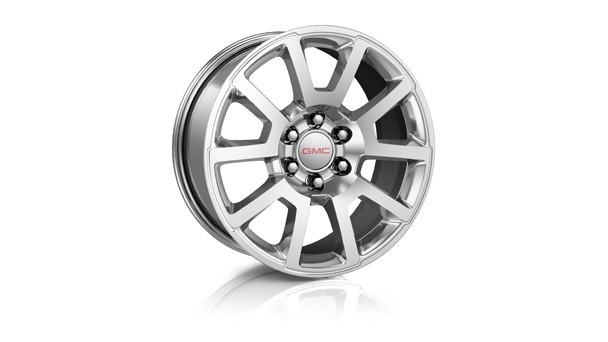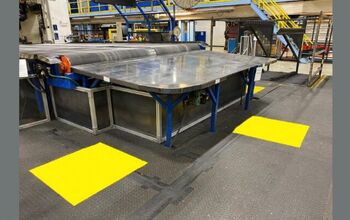Sensible Shoes: Buy the Yukon Denali That Doesn't Look Like a Yukon Denali
Strange as it seems to those of us who clearly remember 16-inch wheels as the sporting option on midsize sedans, 20-inch rims on a 2016 GMC Yukon Denali appear downright tiny.
Indeed, the 20-inchers pictured above are the poverty-spec wheels on the Yukon Denali, a simple way of avoiding a set of $2,495-2,995 22-inch wheels that will — and here’s the kicker — make your Yukon Denali distinctly less comfortable.
Substance over style. Propriety in place of panache. Grace instead of grandeur. From a dynamic standpoint, the 2016 GMC Yukon Denali on 20-inch rims that we tested a few weeks ago was noticeably superior to the 2015 GMC Yukon Denali we tested the previous winter, a vehicle shod with 22-inch wheels which now cost, according to GMC.com, $2,995.
This year’s Yukon Denali tester was all gaping wheel arches and blackwall; this is the Yukon Denali of choice for police departments if police departments bought Yukon Denalis instead of Tahoes; the Yukon Denali that makes people wonder if it’s really a Denali or just a Yukon SLE with $1,400 optional 20s; an emasculated SUV that not-so-proudly announces to the world that you shelled out near-Escalade money for a Tahoe but couldn’t find a few more dimes and nickels behind the couch cushions to properly option it up to typical Denali standards.
This Yukon may be better prepared to deal with the rigors of daily life on the rugged coastal roads of Nova Scotia, but the smaller wheels means we sputtered through the city of Halifax unnoticed, a stark contrast to the eye-catching 2015 Yukon on its dashing, upsized, 7-spoke 22s. Even in understated black paint, that 22-inch-clad (285/45R22 tires) 2015 Yukon Denali incited innumerable second glances, prompted plenty of “How much is it?” queries, and caused Buick Encores to quiver in the right lane, embarrassed to have ever called itself an SUV.
Northerners who spend half the year driving around in red Corolla S sedans on black steelies are surely aghast at the thought of spending an additional $2,995 on a $70,015 full-size SUV just to abide by modern society’s automotive edicts. But style matters in certain sectors more than others, and the upmarket image which is supposed to be conveyed by moving up from Tahoe to Yukon to Yukon Denali — and eventually to Escalade — is largely rescinded if the Yukon Denali appears to be wearing GMC’s version of the Corolla’s black steelies: 10-spoke 20-inch ultra-bright machined aluminum wheels.
But the “small” wheels sure do make the Yukon Denali a far more luxurious vehicle. I won’t disagree with my Simon And Garfunkel-inspired TTAC review of the bigger-wheeled ‘15 Yukon Denali — “the Yukon Denali ignores the worst pavement” — because even the bigger-wheeled Yukon Denali with its wonderfully stout structure manages to beat the most offensive roads into submission. But magnetic ride control works hard to make it so, and there’s always an awareness that the suspension is busily at work analyzing asphalt, studying surfaces, and calculating concrete consistency.
The same can be said of the Cadillac Escalade I tested late last year. It’s not that the ride quality is poor, rather that a vehicle designed to cosset a large number of occupants should better balance the need of looking expensive with the job of providing a magic carpet experience.
Shod with the Yukon’s most basic 20-inch rims (275/55R20 tires) and still equipped with magnetic ride control, the 2016 GMC Yukon Denali becomes downright imperturbable. The worst section of local road is less than a mile from my house, where a fire hydrant erupted a few months ago and the road needed perpetual repaving in the dead of winter. Since it bubbled and burst and caved in on itself, this patch job causes our own Odyssey’s sliding doors to groan, the Audi Q3 ( about which I recently voiced serious wheel complaints) to suffer an anxiety attack upon approach, and the rear end of last week’s Ford F-150 to jiggle about as though it’s auditioning for Drake’s next video.
The Yukon just didn’t care. Yes, there was an awareness of effort being expended if, and only if, you paid close attention. But the very stretch of road that manifests the structural shortcomings of so many other vehicles highlights the impressive work done on the Yukon’s suspension, a trait revealed here because the Yukon has an appropriate amount of unsprung weight.
Exemplary ride quality doesn’t hide the Yukon Denali’s unrelated shortcomings. The interior doesn’t live up to the highfalutin’ price point. Second row legroom is pitiful for a vehicle of this size, or even a vehicle much smaller than the Yukon. The height of the cargo load floor is a joke. No, seriously. My athletic 70-pound dog — who’s rarely permitted in manufacturer-supplied press cars but yearns to plaster them all with hair and mud — was granted an opportunity to jump in the back of the Yukon. She looked at me, looked at the Yukon, looked at me again, and walked away. “You’ve gotta be kidding,” she said, or at least that’s what the angle of her ears intimated.
On the flip side, a stellar powertrain (6.2-liter V8 with 420 horsepower and an eight-speed automatic) produces stunning acceleration figures. Moreover, even real world urban fuel consumption, 17 miles per gallon, is perfectly tolerable given the Yukon Denali’s obscene power and range of capabilities.
Alas, the snug second- and third-row seats create an interior too snug for the demands of my family. But the Yukon is a handsome, powerful, comfortable, imposing brute of an SUV that’s undeniably appealing to legions of buyers.
Curiously, one of the best ways to make the Yukon Denali better is to not spend more money. Stacked up against a Yukon Denali on 22s, this Yukon Denali doesn’t look tough enough or rich enough. But this Yukon is better than that Yukon, and that should simply be enough.
Timothy Cain is the founder of GoodCarBadCar.net, which obsesses over the free and frequent publication of U.S. and Canadian auto sales figures. Follow on Twitter @goodcarbadcar and on Facebook.
More by Timothy Cain
Latest Car Reviews
Read moreLatest Product Reviews
Read moreRecent Comments
- MacTassos Bagpipes. And loud ones at that.Bagpipes for back up warning sounds.Bagpipes for horns.Bagpipes for yellow light warning alert and louder bagpipes for red light warnings.Bagpipes for drowsy driver alerts.Bagpipes for using your phone while driving.Bagpipes for following too close.Bagpipes for drifting out of your lane.Bagpipes for turning without signaling.Bagpipes for warning your lights are off when driving at night.Bagpipes for not coming to a complete stop at a stop sign.Bagpipes for seat belts not buckled.Bagpipes for leaving the iron on when going on vacation. I’ll ne’er make that mistake agin’.
- TheEndlessEnigma I would mandate the elimination of all autonomous driving tech in automobiles. And specifically for GM....sorry....gm....I would mandate On Star be offered as an option only.Not quite the question you asked but.....you asked.
- MaintenanceCosts There's not a lot of meat to this (or to an argument in the opposite direction) without some data comparing the respective frequency of "good" activations that prevent a collision and false alarms. The studies I see show between 25% and 40% reduction in rear-end crashes where AEB is installed, so we have one side of that equation, but there doesn't seem to be much if any data out there on the frequency of false activations, especially false activations that cause a collision.
- Zerocred Automatic emergency braking scared the hell out of me. I was coming up on a line of stopped cars that the Jeep (Grand Cherokee) thought was too fast and it blared out an incredibly loud warbling sound while applying the brakes. I had the car under control and wasn’t in danger of hitting anything. It was one of those ‘wtf just happened’ moments.I like adaptive cruise control, the backup camera and the warning about approaching emergency vehicles. I’m ambivalent about rear cross traffic alert and all the different tones if it thinks I’m too close to anything. I turned off lane keep assist, auto start-stop, emergency backup stop. The Jeep also has automatic parking (parallel and back in), which I’ve never used.
- MaintenanceCosts Mandatory speed limiters.Flame away - I'm well aware this is the most unpopular opinion on the internet - but the overwhelming majority of the driving population has not proven itself even close to capable of managing unlimited vehicles, and it's time to start dealing with it.Three important mitigations have to be in place:(1) They give 10 mph grace on non-limited-access roads and 15-20 on limited-access roads. The goal is not exact compliance but stopping extreme speeding.(2) They work entirely locally, except for downloading speed limit data for large map segments (too large to identify with any precision where the driver is). Neither location nor speed data is ever uploaded.(3) They don't enforce on private property, only on public roadways. Race your track cars to your heart's content.





































Comments
Join the conversation
If I'm getting a GMTK2XX, it's a Tahoe LT. No lower, no higher. EDIT: Damn, $49k for a Tahoe LT on TrueCar? I'm buying slightly used if I have to go full-size SUV.
The bigger rims just look awful and the price of replacing one of those rims and tires from a busting it on a pothole is going to be more awful.